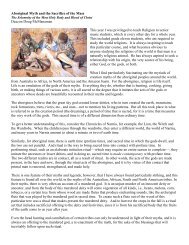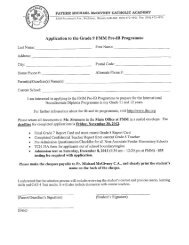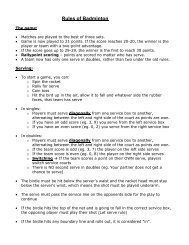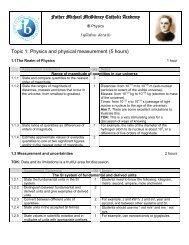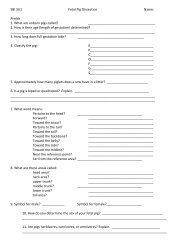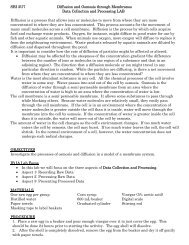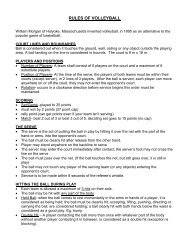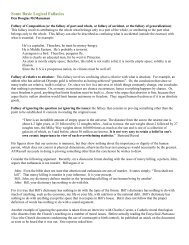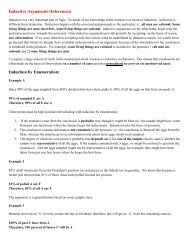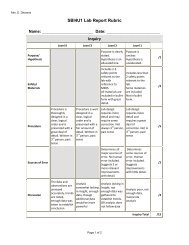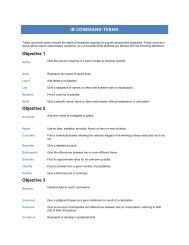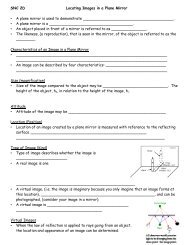Chemistry Review Manual 2
Chemistry Review Manual 2
Chemistry Review Manual 2
You also want an ePaper? Increase the reach of your titles
YUMPU automatically turns print PDFs into web optimized ePapers that Google loves.
(b) NO 2 is a product. Removing it from the reaction mixture results in net forward reaction.<br />
This is a common means of improving product yield. Removing the product from a<br />
reaction mixture drives the reaction in the forward direction.<br />
(c) Doubling the volume of the vessel reduces all partial pressures to 1/2 their initial values.<br />
However, this does not change the reaction quotient because there are two partial<br />
pressure factors in both the numerator and denominator of Q and they have the same<br />
exponents. Decreasing all partial pressures by the same factor thus has no affect on the<br />
reaction quotient. Therefore, the system is still at equilibrium. This is consistent with le<br />
Châtelier's principle, which says that the reaction will shift to the side with more moles of<br />
gas so as to counter the reduction in total pressure caused by the increase in volume.<br />
However, neither forward nor reverse reaction increases the moles of gas. Therefore,<br />
the mixture remains at equilibrium.<br />
(d) The reaction is exothermic. Increasing temperature favors reactants (the endothermic<br />
direction of reaction) – i.e., there is net reverse reaction.<br />
(e) HCl is a product. Increasing its partial pressure results in net reverse reaction.<br />
(f) NH 4 Cl(s) is a pure solid. Adding it or removing some of it from the reaction mixture has<br />
no effect on the equilibrium as long as some of the solid remains. No net reaction results.<br />
(g) The reaction is endothermic. Decreasing temperature favors reactant (the exothermic<br />
direction of reaction) – i.e., there is net reverse reaction.<br />
The equilibrium constant allows quantitative determination of final equilibrium conditions. Such<br />
determinations are carried out by constructing an ICE table to relate equilibrium activities to the<br />
extent of reaction. This begins with the balanced chemical reaction. Below that are three rows.<br />
The first row shows the initial (I), non-equilibrium concentrations/partial pressures of reactants<br />
and products. The second row expresses the changes (C) in these concentrations (that occur<br />
upon achieving equilibrium) in terms of the unknown extent of reaction. This row accounts for the<br />
stoichiometric coefficients in the reaction. The third row is the sum of the first two rows. It gives<br />
the concentrations/partial pressures at equilibrium (E). For example, consider the reaction of<br />
water vapor and carbon monoxide, both initially at 1.00 atm partial pressure. K = 0.63 for this<br />
reaction at a certain T.<br />
H 2 O(g) + CO(g) <br />
H 2 (g) + CO 2 (g)<br />
Initial 1.00 1.00 0 0<br />
Change −x −x +x +x<br />
Equilibrium 1.00 − x 1.00 − x x x<br />
Here, x is the extent of reaction, appearing as a change in partial pressure. If one of the species<br />
had a stoichiometric coefficient greater than 1, it would multiply x in the associated cell. Having<br />
expressed the equilibrium concentrations in terms of the unknown x, we construct the equilibrium<br />
constant equation in terms of x.<br />
K<br />
⎛ p p ⎞<br />
xx<br />
= = =<br />
⎜ p p ⎟<br />
⎝ ⎠<br />
−x −x<br />
H2 CO2<br />
⎟<br />
0.63<br />
HO 2 CO<br />
(1.00 )(1.00 )<br />
eqm<br />
Page 46 of 88



